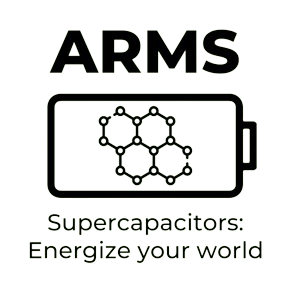GENERAL INFORMATION ABOUT THE PROJECT
- Programme: European Union Horizon Europe
- Duration: 4 years
- Consortium: 11 partners
- Coordinator: Tampere University (TAU)
- Total budget: EUR 4 498 901.25
Click here to find out more about funding decision and related details of ARMS project
The ARMS project aims to revolutionize energy storage solutions by developing innovative supercapacitors that are both eco-friendly and highly efficient. By integrating advanced materials, such as graphene-rich bio-based carbon, and utilizing cutting-edge manufacturing technologies like atomic layer deposition (ALD), ARMS aims to create supercapacitors with energy densities comparable to traditional batteries, while maintaining superior power density and cycle life. The project not only addresses the growing demand for sustainable energy storage options but also strengthens Europe's position in the global market for clean energy technologies.
Our project focuses on building a new value chain for supercapacitor manufacturing, engaging various European partners, from research institutions to industry. Through collaborative efforts, ARMS aims to deliver safe, affordable, and high-performance energy storage solution that can be applied across a range of applications, from consumer electronics to electric vehicles. Committed to sustainability, we prioritize the use of non-toxic materials and processes, contributing to a greener and more circular economy.
PROJECT OBJECTIVES
Objectives encompass a range of goals aimed at transforming the field of supercapacitors:
- Scalable fabrication of graphene-containing bio-based carbon materials for effective electrodes.
- Fabricate graphene-enhanced electrodes for micro-flexible and structural supercapacitors.
- Develop a scalable atomic layer coating process.
- Develop aqueous hybrid electrolyte systems for prototype supercapacitors.
- Manufacturing of flexible and structural supercapacitor devices with enhanced energy density.
- Early guidance sustainable-by-design framework and life cycle sustainability assessment.
The project partners will achieve these goals by a combination of factors, working in a coordinated fashion: process modification to enable the production of high-graphene-content porous carbon for printed flexible energy storage, conformal graphene coating onto carbon fibres for structural supercapacitors, decoration of both types of electrodes with ultra-thin conformal ALD coating of MnO2 and Fe2O3 for increased stability and voltage window, and development of novel, environmentally-friendly electrolytes.
The energy storage devices enabled by this work will be integrated into two use-case demonstrators to show the viability of the concept: a wireless sensor device powered by a printed flexible supercapacitor and a drone powered by structural supercapacitors, which are simultaneously structural parts of the drone.
